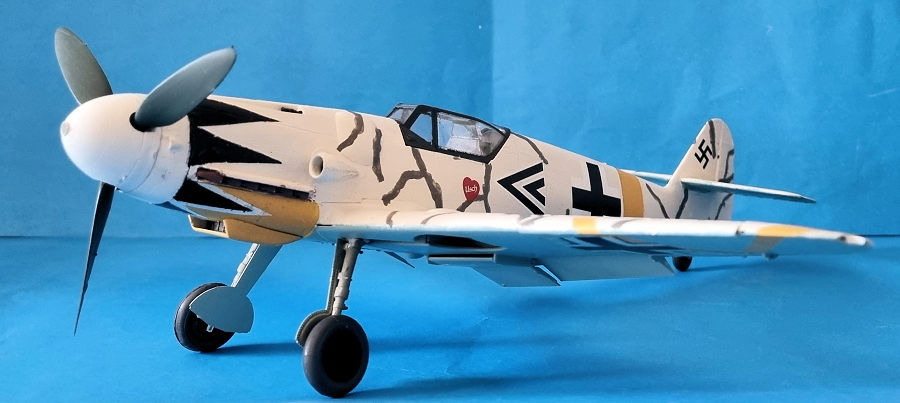
Revell 1/32 Bf-109G-6
| KIT #: | 4665 |
| PRICE: | 71$ |
| DECALS: | Two Options |
| REVIEWER: | Francisco Santoro |
| NOTES: | Hartmann's last 109 |

| HISTORY |
From the kit instructions: "By the Autumn of
1941, the Bf 109F had already been in service for half a year. Despite the good
results that had been achieved through constant development, Messerschmitt was
still aware of the need for further improvement of the aircraft. Average speeds
and altitudes flown in aerial battles, particularly against the Western Allies
had rapidly increased. The requirement for a pressurised high altitude variant
of the fighter was on the list of demands for the G series right from the
beginning. When development finally began a power unit that could perfectly
fulfill this requirement was already available in the form of the Daimler Benz
DB 605A. Based on the DB 601, the DB 605 had an increased displacement and a
higher compression ratio
 whilst remaining identical in size to its predecessor.
Installation into the Bf 109's airframe therefore proved to be relatively straighforward. The higher performance and greater engine torque however,
required structural changes in the airframe, which increased the empty and
takeoff weights of the aircraft. Together, the increase in weight and
performance compared to the F series led to significantly poorer handling
qualities, a disadvantage that had to be accepted in light of the apparently
improved flight performance.
whilst remaining identical in size to its predecessor.
Installation into the Bf 109's airframe therefore proved to be relatively straighforward. The higher performance and greater engine torque however,
required structural changes in the airframe, which increased the empty and
takeoff weights of the aircraft. Together, the increase in weight and
performance compared to the F series led to significantly poorer handling
qualities, a disadvantage that had to be accepted in light of the apparently
improved flight performance.
Known as the G-1, the new variant went into
mass production from February 1942, but it still had the armament of its
predecessor. This was to change with the introduction of the parallel
developments Bf 109G-5 and G-6, both of which were delivered to service units
from March 1943 onwards. As on the G-1, the G-5/6 were fitted with an MK 151/20
20mm cannon firing through the engine block. The MG 17s mounted above the engine
were replaced by two 13mm MG 131s. The belt-feed to the uprated armament made a
redesign of the aerodynamic engine cover necessary which gave the aircraft its
characteristic "bumps." Whilst the G-5 was still fitted with a pressurised
cabin, the G-6 was not (all other technical characteristics remained the same).
The price for the uprated armament was a further increase in curb weight
resulting in further reduction in flight performance. By default the two new
variants were fitted with the strengthened landing gear and larger wheels
introduced onto later aircraft of the G-3 and G-4 variants. This was evident by
the drop shaped bulges on the upper surface of the wings. The G-6 was used
e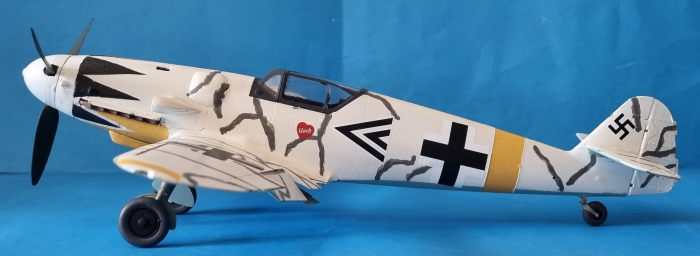 xtensively on all fronts from March 1943 until the end of the war. With a total
of 13000 machines, she was the most prolific of all Bf 109s, but at the time of
its introduction it had already passed the peak of its development. Improvements
included a revised head armour for the pilot (also called Galland Armour), a
shorter aerial mast, simplified MG cover plates and a new canopy from the Erla
machine factory. The Erla canopy (often mistakenly called Galland Canopy)
replaced the old canopy and fixed rear windows with a new, one piece design
which dramatically improved visibility to the rear. The tail was also modified
by increasing its size and fitting a rudder that was taller and larger in area.
Developed for the Bf 109G-10, this tail was incorporated into later production
batches of the G-6, and was intended to improve flight stability. In order to
compensate for the reduction in speed, later G-6s received the DB 605AM engine
and the so called MW-50 unit using a mixture of water and methanol. This could
be used to increase engine output to 1800hp for about 10 minutes through
injection to the intercooler. Most of these modifications and alterations were
built and fitted partly in Field Workshops, but were collectively adopted by
Messerschmitt and from August 1944 incorporated into the Bf 109G-14."
xtensively on all fronts from March 1943 until the end of the war. With a total
of 13000 machines, she was the most prolific of all Bf 109s, but at the time of
its introduction it had already passed the peak of its development. Improvements
included a revised head armour for the pilot (also called Galland Armour), a
shorter aerial mast, simplified MG cover plates and a new canopy from the Erla
machine factory. The Erla canopy (often mistakenly called Galland Canopy)
replaced the old canopy and fixed rear windows with a new, one piece design
which dramatically improved visibility to the rear. The tail was also modified
by increasing its size and fitting a rudder that was taller and larger in area.
Developed for the Bf 109G-10, this tail was incorporated into later production
batches of the G-6, and was intended to improve flight stability. In order to
compensate for the reduction in speed, later G-6s received the DB 605AM engine
and the so called MW-50 unit using a mixture of water and methanol. This could
be used to increase engine output to 1800hp for about 10 minutes through
injection to the intercooler. Most of these modifications and alterations were
built and fitted partly in Field Workshops, but were collectively adopted by
Messerschmitt and from August 1944 incorporated into the Bf 109G-14."
| THE KIT |
The model is moulded in a soft, light grey plastic with some hints of flash on some parts. In total, there're 15 sprues and a single clear one. There're two decal options provided, a Bf 109G-6 Late (tall vertical stabilizer, Galland canopy) of Franz Dorr when with JG 5 "Eismeer," and Karl Rammel's G-6 Early (shot vertical stabilizer and regular canopy). Both planes have mottling, the first one being light and the latter one having a heavier mottling.
| CONSTRUCTION |
I meant to write this review earlier this year, but I kept procrastinating and building other models. I also started university, which pushed me further away from review writing and modelling. I have been able to find some time to put models together though.
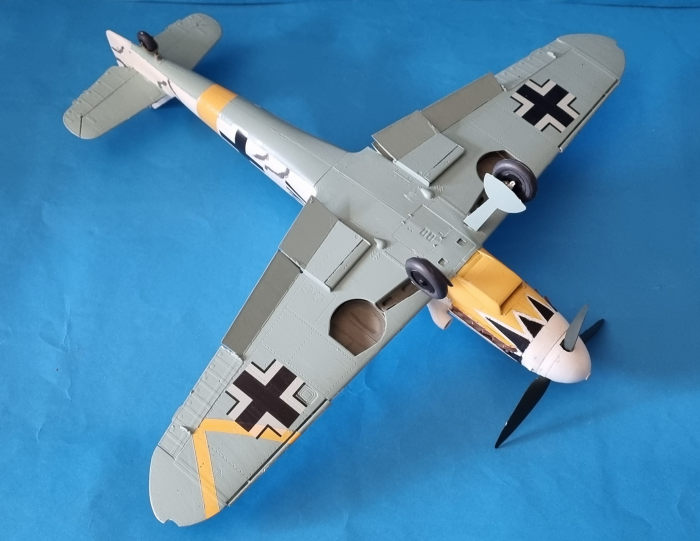 Construction started by pre-painting the
cockpit and landing gear wells in RLM 66 and RLM 02. While that was drying, I
took out the clear parts and painted the fuel line yellow with black borders,
making sure to leave the central section clear. I then put the cockpit together.
I also glued the wingspar (painted first in RLM 02) under the cockpit. They then
were added to a fuselage half. While the glue was curing, I glued the exhausts
to the fuselage halves. I also put together the machineguns, radiator, oil
cooler, nose bulges (making sure to choose the correct parts for the tall
vertical stabilizer variant). Once I had completed these assemblies, I glued the
fuselage halves together and added all the aformentioned parts to the completed
fuselage. I then proceded to glue the inner sections of the wings, making sure
to align them perfectly with the roots of the fuselage. The wheel wells were
also built and glued each to the inner section of the wings. Once that was done,
I added the top and lower wings. While those were drying, I picked the tall tail
and glued it to the empennage, while building at the same time the horizontal
stabilizers. The next step was to glue the flaps and slats in the extended
position. This was done and then I left the model overnight for the glue on the
flaps to go off and harden.
Construction started by pre-painting the
cockpit and landing gear wells in RLM 66 and RLM 02. While that was drying, I
took out the clear parts and painted the fuel line yellow with black borders,
making sure to leave the central section clear. I then put the cockpit together.
I also glued the wingspar (painted first in RLM 02) under the cockpit. They then
were added to a fuselage half. While the glue was curing, I glued the exhausts
to the fuselage halves. I also put together the machineguns, radiator, oil
cooler, nose bulges (making sure to choose the correct parts for the tall
vertical stabilizer variant). Once I had completed these assemblies, I glued the
fuselage halves together and added all the aformentioned parts to the completed
fuselage. I then proceded to glue the inner sections of the wings, making sure
to align them perfectly with the roots of the fuselage. The wheel wells were
also built and glued each to the inner section of the wings. Once that was done,
I added the top and lower wings. While those were drying, I picked the tall tail
and glued it to the empennage, while building at the same time the horizontal
stabilizers. The next step was to glue the flaps and slats in the extended
position. This was done and then I left the model overnight for the glue on the
flaps to go off and harden.
Meanwhile, I put together the landing gear and wheels. These were painted RLM 02 and RLM 66 tyres with black hubs. To cut even more waiting time, I put the propeller together. The nose cone was painted white with RLM 70 propellers.
| COLORS & MARKINGS |
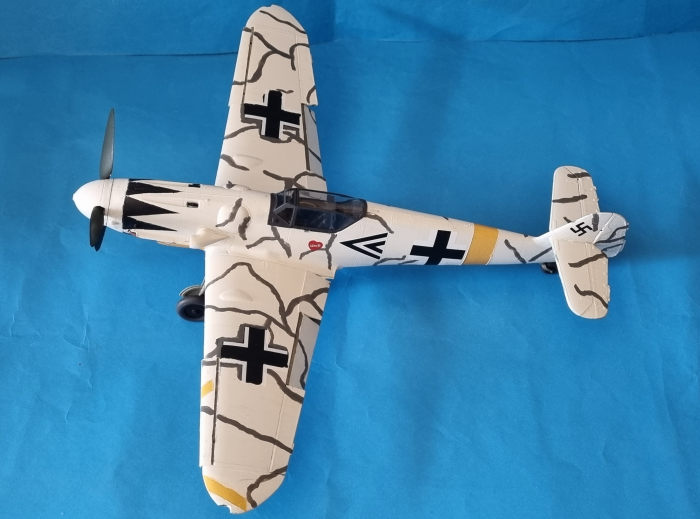 I chose to paint this aircraft as Erich
Hartmann's last plane while he was stationed with JG 53 in Hungary. This
aircraft was covered in white paint with random lines of RLM 75 over the wings
and fuselage, and Hartmann's famous tulips. I first outlined the tulips with a
pencil, and the painted the lower side of the nose white (because the lower
tulips had a white outline, whereas the upper tulips were solid black). I then
masked the tulips, making sure I covered them in tape prior to painting the main
camouflage, and painted the lower nose in yellow. The model was then painted
Revell Matt 05 White. This took some time since white takes some coats to
properly cover the surface. Once the entire plane had been painted with the
basic camouflage, I made a rough guide where the upper Balkenkreuzesn should go,
and painted the area black. This aircraft also had a yellow triangle on the left
wing. I masked the area and painted the yellow. Once that was done, I painted
the undersides RLM 76. After that, I added the RLM 75 squiggles to the surface.
Once the squiggles were dry, i glossed the aircraft.
I chose to paint this aircraft as Erich
Hartmann's last plane while he was stationed with JG 53 in Hungary. This
aircraft was covered in white paint with random lines of RLM 75 over the wings
and fuselage, and Hartmann's famous tulips. I first outlined the tulips with a
pencil, and the painted the lower side of the nose white (because the lower
tulips had a white outline, whereas the upper tulips were solid black). I then
masked the tulips, making sure I covered them in tape prior to painting the main
camouflage, and painted the lower nose in yellow. The model was then painted
Revell Matt 05 White. This took some time since white takes some coats to
properly cover the surface. Once the entire plane had been painted with the
basic camouflage, I made a rough guide where the upper Balkenkreuzesn should go,
and painted the area black. This aircraft also had a yellow triangle on the left
wing. I masked the area and painted the yellow. Once that was done, I painted
the undersides RLM 76. After that, I added the RLM 75 squiggles to the surface.
Once the squiggles were dry, i glossed the aircraft.
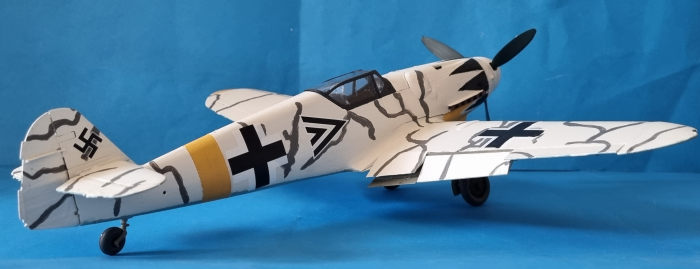 Decals came from three sources: The original
kit decals for the fuselage and wing crosses, lower crosses from the Hasegawa Bf
109G-6, and the heart emblem from a 1:48 Ta 183 from Academy. These worked
nicely and were softened into place with Microsol. I then left the Microsol to
evaporate and matt coated the aircraft the next day.
Decals came from three sources: The original
kit decals for the fuselage and wing crosses, lower crosses from the Hasegawa Bf
109G-6, and the heart emblem from a 1:48 Ta 183 from Academy. These worked
nicely and were softened into place with Microsol. I then left the Microsol to
evaporate and matt coated the aircraft the next day.
I added the landing gear, wheels, gear doors, gunsight and clear parts. The left landing gear was still soft after a couple of hours (even though I hadn't used a lot of glue), so I cut a piece of sprue and glued it at the base of the leg). The clear parts were glued in the closed position with white glue. The propeller was then glued in place (because I dropped the model nose first into my workbench and broke the prop shaft), and I could call this model complete.
| CONCLUSIONS |
I enjoyed putting this model together. Revell provides a nice package between detail and price in the big 109 scale market. So far, their kit is the only one readily available on sale, the Hasegawa one being out of production. Zoukei Mura is also preparing to release the entire G family of the Bf 109, but that one is for another review.
10 January 2023 Copyright ModelingMadness.com. All rights reserved. No
reproduction in part or in whole without express permission. If you would like your product reviewed fairly and
fairly quickly, please
contact
the editor or see other details in the
Note to
Contributors.